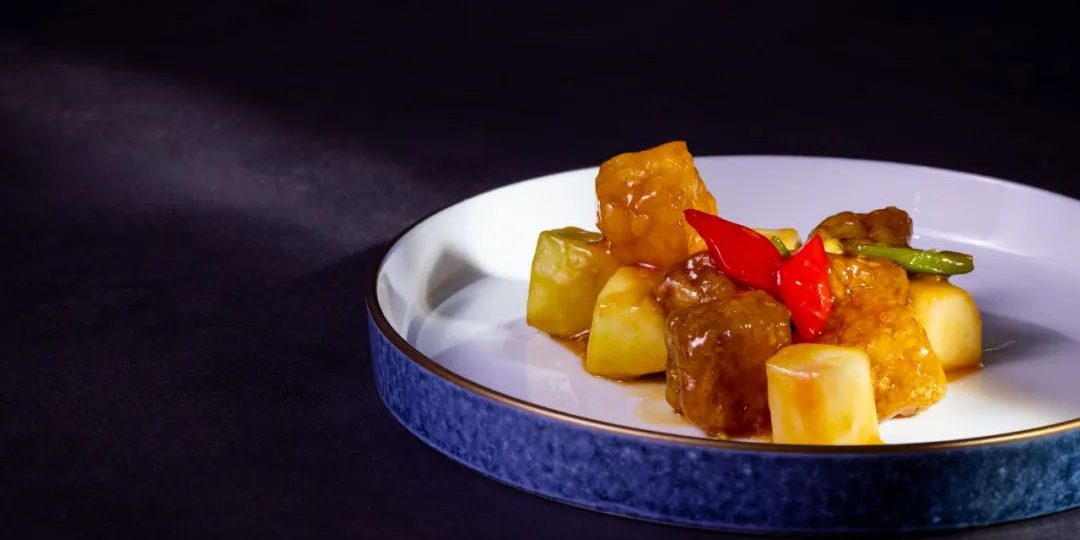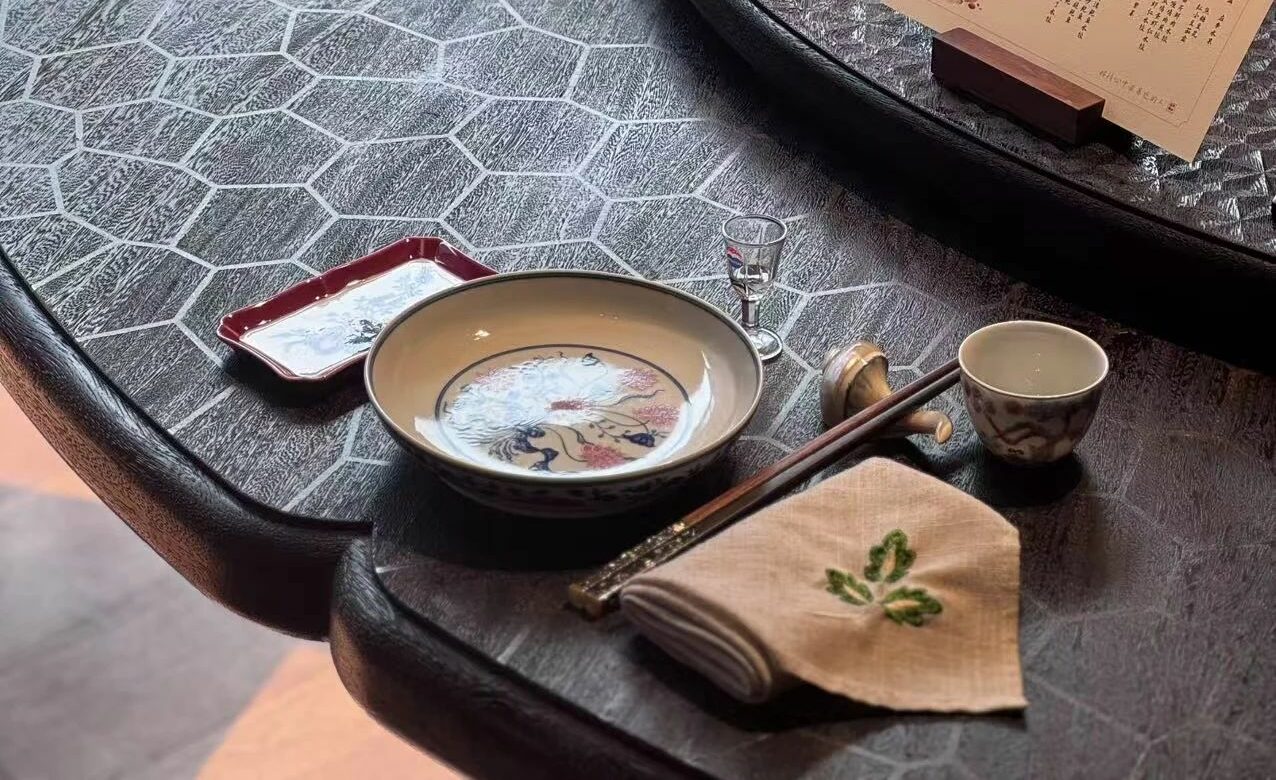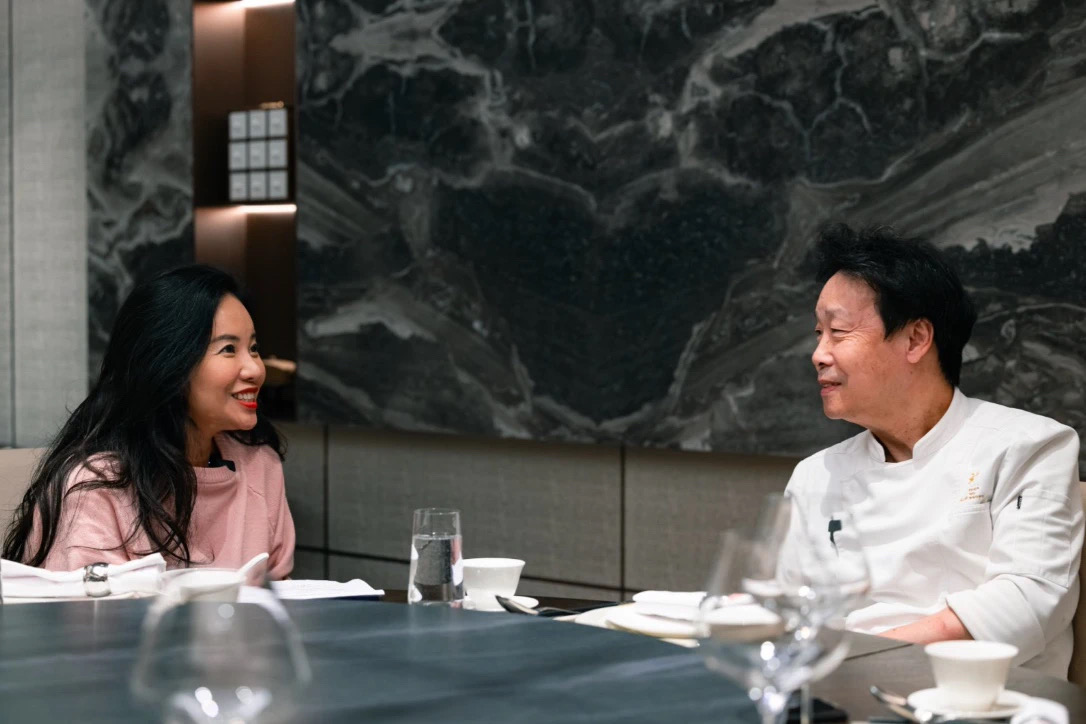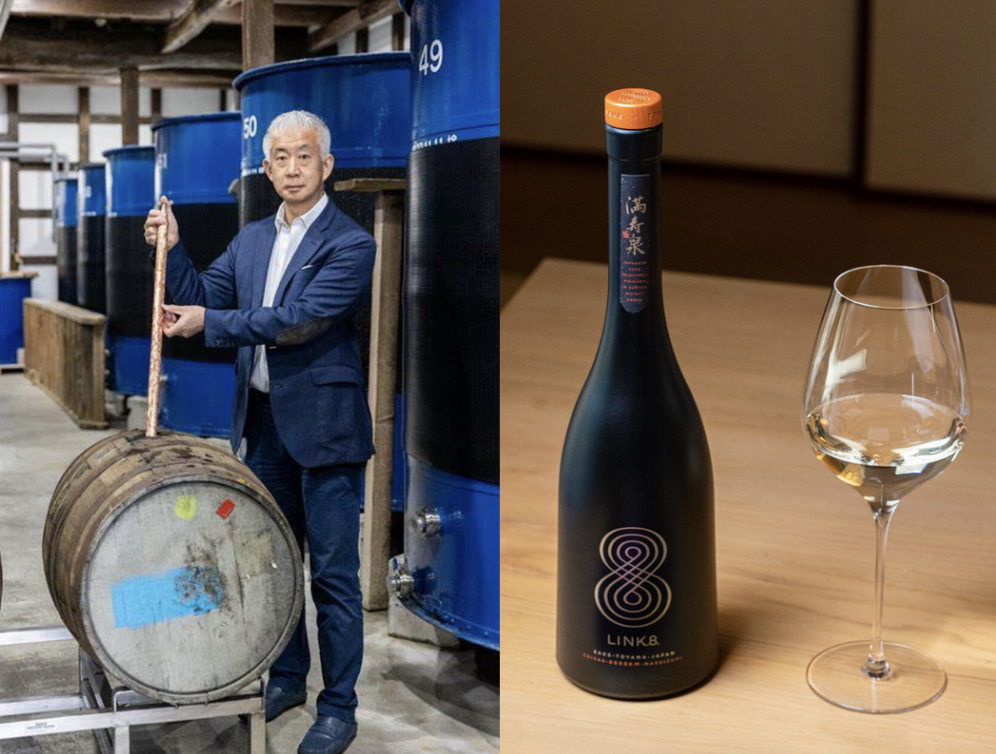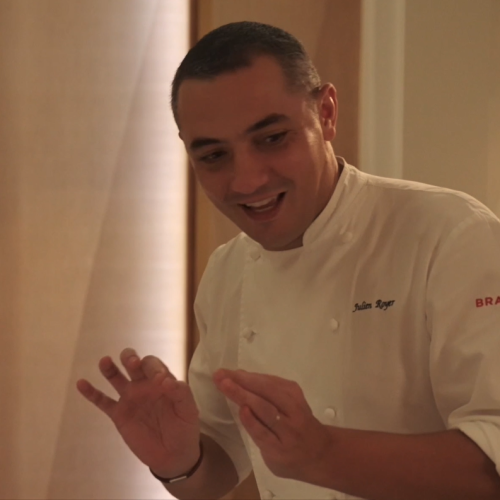The author:Jocelyn Chen
Chinese cuisine is vast and profound, and my introduction to Guangzhou cuisine began at 102 House Foshan. The restaurant came to Shanghai last summer and has undergone two renovations in between, but I have already tried its summer, autumn and winter menus. The seemingly simple dishes are loaded with unpretentious skills and rock-solid knowledge of Chef Xu Jingye, who has made Guangzhou cuisine so purely classic yet elaborately eye-opening.
Chef Xu’s startup originally focused on fusion cuisine, because he had thought traditional dishes were outdated, but diners didn’t seem to like ordering creative dishes a lot, and later on Chen Daben, his cooking teacher, pointed out the importance of tradition. As a result, Chef Xu began shifting his attention to Guangzhou cuisine in its purest, oldest form, and became even mesmerised by old recipe books in search of once-treasured, lost flavours.
And then I heard from Singaporean journalist and restauranteur David Yip, that Chef Xu had visited most of the Michelin restaurants in Kyoto, spending a year of his salary, to gain deeper undertanding for the relationship between food and the turn of the seasons.

Chef Jing Xuye
Guangzhou cuisine
Before learning about Guangzhou cuisine, the question that lingered in my mind was what exactly is Cantonese cuisine? There are three major styles in Cantonese Cuisine: Guangzhou, Chaoshan and Hakka. 102 House specialises in Guangzhou cuisine, which enjoys an established historical trajectory and lays claim to a variety of venerable traits after early economic boom.
The aesthetic of 102 House features reserved black and hues of antique gold, together with the dishes and tableware, all exuding Chef Xu’s understanding of the qualities of Lingnan culture and the ability to substantiate it into concrete forms. Chef Xu jokingly told me that he would describe his restaurant as “plain outside, sexy inside”, as you can tell from each detail.



I visited 102 House Foshan earlier last year. Nestled in an old mansion in a quiet neighbourhood, the restaurant is not particularly eye-catching from the outside, but there is something special when you walk through the door. The petite courtyard is empty except for the trees, and there is a charcoal pile at the entrance to the courtyard to cook food. The space is simply furnished to give an air of the ’80s nostalgia.
Well publicised in the Western media and recognised by the gourmets’ circle, 102 House Foshan has been a popular destination for customers from Hong Kong, Taiwan and Singapore, but a trip there is not without a lot of travelling. Although Foshan has an airport, most people still choose to fly to Shenzhen or Guangzhou first and then drive there, like I did last time.
At the time I had limited appetite for food due to the otitis media, but I was still amazed by the Sweet and Sour Pork, especially the crispy pork lard, full of aroma without a hint of greasiness. Later on I realised that this was just a gateway to other refined dishes that I was yet coming to satiate.


Then we talked about the Shanghai plan, which would be situated in the hectic area of the Bund. My concern was that the location would have lesser association with the low-key and unpretentious positioning of the Foshan restaurant and the real sense of Guangzhou cuisine, which is not about glamour, but about speed, vitality and heat. It turned out my concern was unnecessary, because the quaint House of Roosevelt and the Chinese calligraphy plaque on the front door still retain a touch of the old days and an understated temperament.
Danny Yip, owner of The Chairman in Hong Kong, describes Xu Jingye as one of the few chefs of his time who excels in putting in the effort, attention to detail and respect for tradition in his seemingly simple cooking. I’m still learning Guangzhou cuisine, but I’ve tried the summer, autumn and winter menus of 102 House about a dozen times, so I should be in a position to talk about the dishes.


Four Hands: The Chairman x 102 House; 102 House Chef Xu Jingye & Owner Yao Min
The dishes are just like the artist behind them. Out of the three seasonal menus, the summer menu is more about straightforward dishes with many impressive highlights.
Cold dishes is not a particular focus for Guangzhou banquet cuisine, which usually kicks off with two cold platters and then the stir fries. And because Cantonese cuisine stresses nourishment, serving soup is considered the official start of the banquet. You will find two or three soup dishes in each of Chef Xu’s seasonal menus that honour the change of seasons while refreshing your palate for a delicious memory.
Summer
Many dishes on the summer menu were simply so gorgeous that got me carried away for a moment. The Crystal Prawns, for example, are made from large-size, three-head prawns, which are neatly shelled and deveined with a razor blade and then carefully butterflied multiple times. When stir fried in the wok, the crystal white prawns blossom like dancing flowers while the inside remains a soft-tender, semi-cooked state. Unlike other restaurants where prawns are soaked in lye water or baking soda to keep them bouncy and crispy, 102 House sticks to the traditional method of marinating with salt and dehydrating the prawns to best maintain their original flavour. Truly representing the freshness, umami, crispness, tenderness and smoothness, together with the addition of prawn roe to enhance the richness, this is one of the best prawn dishes you could have in Shanghai. Chef Xu once offered to upgrade the dish with lobster, but I kindly declined because it is already praiseworthy for bringing a prawn dish to this level of performance.



From Top to Bottom: Deep-fried Sea Urchin Broth/Smoked Pork Shoulder with Tea Leaves/Lotus Pond Strange Swallow Soup
Inspired from a traditional Guangzhou dish – fried chicken testicles, Deep-fried Sea Urchin Broth uses sashimi-quality short-spine sea urchin in superior soup and deep-fried to give it a wonderfully airy taste that melts in your mouth. Fewer restaurants are willing to make this dish due to its complicated preparation process.
Smoked Pork Shoulder with Tea Leaves uses top-quality Jinghua pork, smoked and cured with light brown sugar and two kinds of tea leaves, Tieguanyin and Dancong. The addition of 4-to-5-year Tuwei rose syrup gives rise to an indulgent combination of smoky body and aromatic, rosy end note, seemingly ordinary but actually intricately layered and thoughtfully designed. The layout, the execution, and the production of the summer menu is so outstanding that it’s already a two-star performance.
Autumn
The Sliced Pork Stomach Stuffed with Salty Egg Yolk, Preserved Egg and Ham is a classic dish commonly found on the tables of Cantonese families during the Chinese New Year, while it takes resemblance from its fully-textured and richly-flavoured French counterpart – Terrine (a dish of layered ground meats, vegetables and seasonings, packed tightly into the shape of a loaf). In this almost lost recipe, pork belly is stuffed with salted egg yolk, ham and coriander, and brought to boil over a low heat before cooled down and carefully sliced. The intertwining aromas and layers of flavour pleasantly kick off the autumn menu.
Quick-fried Squab and Sea Conch is a typical Guangdong stir-fry dish made with finely-sliced 28-day old, large-size, deboned Zhongshan squab and sliced conch from the East China Sea. A delightful, lingering surf-and-turf dish accompanied by the crisp conch and tender, smooth squab meat.
In Crispy Fish Maw with Crab Roe, by mixing succulent Cantonese virgin crabmeat and mellow Pengqi crab paste instead of hairy crab, the dish speaks true of Cantonese culinary style that’s fresh but not crude, light but not bland. Furthermore, it is served with a hearty portion of thick, soft ling fish maw, and topped off with a sprinkling of lemon leaves for a zippy end note.



The Sliced Pork Stomach Stuffed with Salty Egg Yolk, Preserved Egg and Ham/Quick-fried Squab and Sea Conch/Crispy Fish Maw with Crab Roe
Blanched Geoduck with Crispy Vermicelli is a main course. Rice vermicelli is deep-fried and quickly doused in soup, then served in a bowl with sliced geoduck, shiitake mushroom and turnip. When served, the soup is poured over, filling every bits of the ingredients while a dash of dried flounder fish floss infusing richness and delicacy to the whole. The muscular geoduck, savoury broth and crisp vermicelli all round off to bring out the best of each other.

Blanched Geoduck with Crispy Vermicelli
Winter
The Chaozhou-style Grilled Eel features fatty winter eel roasted over a charcoal fire to a crispy exterior and soft interior. An interesting part of this dish is the use of chrysanthemum crisps, a unique Guangdong fare made by crushing sweetened dried chrysanthemum petals. The flavour-packed chargrilled eel is perfectly balanced by a dash of the crisp chrysanthemum, slightly sweet but not overshadowing the protagonist.

Chaozhou-style Grilled Eel
Francolin Congee with Bird’s Nest and Ham: There it goes the first soup dish in a Guangzhou banquet, well not strictly a soup, but a bowl of warm congee made with mashed greater yam simmered in an essential Francolin stock. A highly nutritious bird meat, the Francolin is deboned and pounded on top of pork skin to effectively absorb the aroma and juice of the meat. Bird’s nest and ham are added before serving for a rich, savoury and smooth taste that also brings us closer to the official start of the menu.
Steamed Rice with House Special Sausage, Pickled Dry Mustard and Pork: The topping of the clay pot rice is a combination of 102 House Foshan special sausage, coupled with pickled dry mustard and pork. Unlike the local version in Shanghai which uses soy sauce, here it uses fermented tofu sauce, rich and thick enough to soak the rice without compromising its firmness and non-stickiness.


Francolin Congee with Bird’s Nest and Ham/ Steamed Rice with House Special Sausage, Pickled Dry Mustard and Pork
Signature Sweet and Sour Pork
Carried over from Foshan to Shanghai, this is a permanent item on 102 House’s menu throughout the year. The restaurant particularly selects a small piece of fatty pork between the loin and the belly, marinates and fries the lard to produce a clear and crispy crust covered with sweet and sour sauce. Take a bite and you will be taken aback by the airy texture that completely dissolves in the mouth. Strawberries and strawberry vinegar are used in the winter menu for blending in a gentler hint of acidity and sweetness. But the pairing fruit varies according to the season: Beijing peach for autumn, baby ginger for summer.
Chef Xu stresses the relevance of dishes in the menu design, which should be a complete story with beginning, development and end, rather than a monotony of culminations and climax, hence the lead-in dishes in his set menus. I appreciate his culinary style, which basically follows a few guiding principles, one being stir-fries must be quick and precise, not heavyhanded on plating, and must be consumed in time after serve.



In order: Summer, fall and winter versions of Signature Sweet and Sour Pork
Veg or meat?
The Braised Bamboo Fungus in Superior Sea Conch Broth from the autumn menu is typical of those meat dishes where you don’t actually see any meat in it. Sea conches, Chuanbei Mu (fritillaria cirrhosa bulb) from northern Sichuan, old tangerine peel and pear are simmered until completely turned into a creamy, buttery soup base, then the meaty bamboo fungus and ham are added to fully absorb the essence of the stock and transform into a textured mouthfeel as they complement the whole, which also sets the scene for the rest of the dishes.Similarly, the Simmered Shiitake with Turnip from the winter menu uses shiitake mushrooms from North Guangdong, a much sought-after ingredient for their velvety, meaty texture and strong, earthy flavour. Here the organic shiitake mushrooms from Nanxiong, Shaoguan City in North Guangdong are used and stewed together with beef brisket, Shōgoin kabu turnip (a local vegetable of Kyoto) and mullet roe, to produce a broth in which the turnip is boiled until fully absorbs the essence of the stock and turns a clear brownish colour. A heavenly good dish that officially melts my heart away.


Braised Bamboo Fungus in Superior Sea Conch Broth/ Simmered Shiitake with Turnip
Chef Xu’s culinary logic
The seemingly simple dishes are treated using complex techniques such as grilling and smoking, with more emphasis on using different varieties of the same ingredient to add flavour. Pork lard, shrimp oil, Jinhua ham oil, crab oil, chicken oil… Chef Xu is obsessed with all kinds of fats in order to bring out the best flavours of the ingredients in his cooking.
The autumn dessert Chestnut and Osmanthus Dew uses two types of chestnuts, and his crab dishes usually combine more than one type of crab. It reminds me of Riccardo’s pasta dish at Otto e Mezzo BOMBANA in Macau, where multiple white truffles are shaved into the pasta to bring in varied flavours. Chef Xu is doing the same thing – adding complexity by adopting a broader spectrum of the same ingredients.

Chestnut and Osmanthus Dew
The autumn dessert Chestnut and Osmanthus Dew uses two types of chestnuts, and his crab dishes usually combine more than one type of crab. It reminds me of Riccardo’s pasta dish at Otto e Mezze BOMBANA in Macau, where multiple white truffles are shaved into the pasta to bring in varied flavours. Chef Xu is doing the same thing – adding complexity by adopting a broader spectrum of the same ingredients.
I would say the complexity, consistency and craftsmanship of the dishes at 102 House have reached Michelin standards. With more Michelin inspectors being Hong Kong people, appreciating the intricacies of Guangzhou cuisine should not be a barrier. Chef Xu has a Cantonese nickname by his close friends – Shu Mai (薯唛, derives from the English word schmuck), which means “silly” in a good way, but I still refer to him as Chef Xu or Master Xu, because I believe his solid skill repertoire should make him a strong candidate to let Chinese cuisine shine in the global arena. He already had experience instructing Japanese chefs on Chinese cooking techniques during his visit in Osaka, recorded in the documentary series A Taste of Canton; and his mentor-friend relationship with Danny Yip of The Chairman in Hong Kong is a widely acknowledged story in the restaurant industry. His dishes are just like him, unassuming, heart-soothing, hard-working and full of perspectiveness and acuity.
Chef Xu says that the Lingnan region basically covers the modern Chinese provinces of Guangdong, Guangxi and Hainan, and it’s a place where aesthetics and food are self-contained. The tableware including chopsticks are made to traditional Lingnan standards, hoping to convey to its diners the allure of authentic Cantonese and Lingnan culture – unshowy yet full of “sexy” details for other to find out and truly appreciate.
To encourage diners to enjoy the dishes at best temperatures, they serve one dish at a time with intervals for leisurely conversation. Maybe “carpe diem” is the right phrase here. 102 House is the perfect getaway for food lovers who feel like a laid-back culinary indulgence in the aura of yore back in Guangzhou’s good old times.
In his early thirties, young chef Xu Jingye is quietly reviving ancient Cantonese culinary traditions with great expectation.



